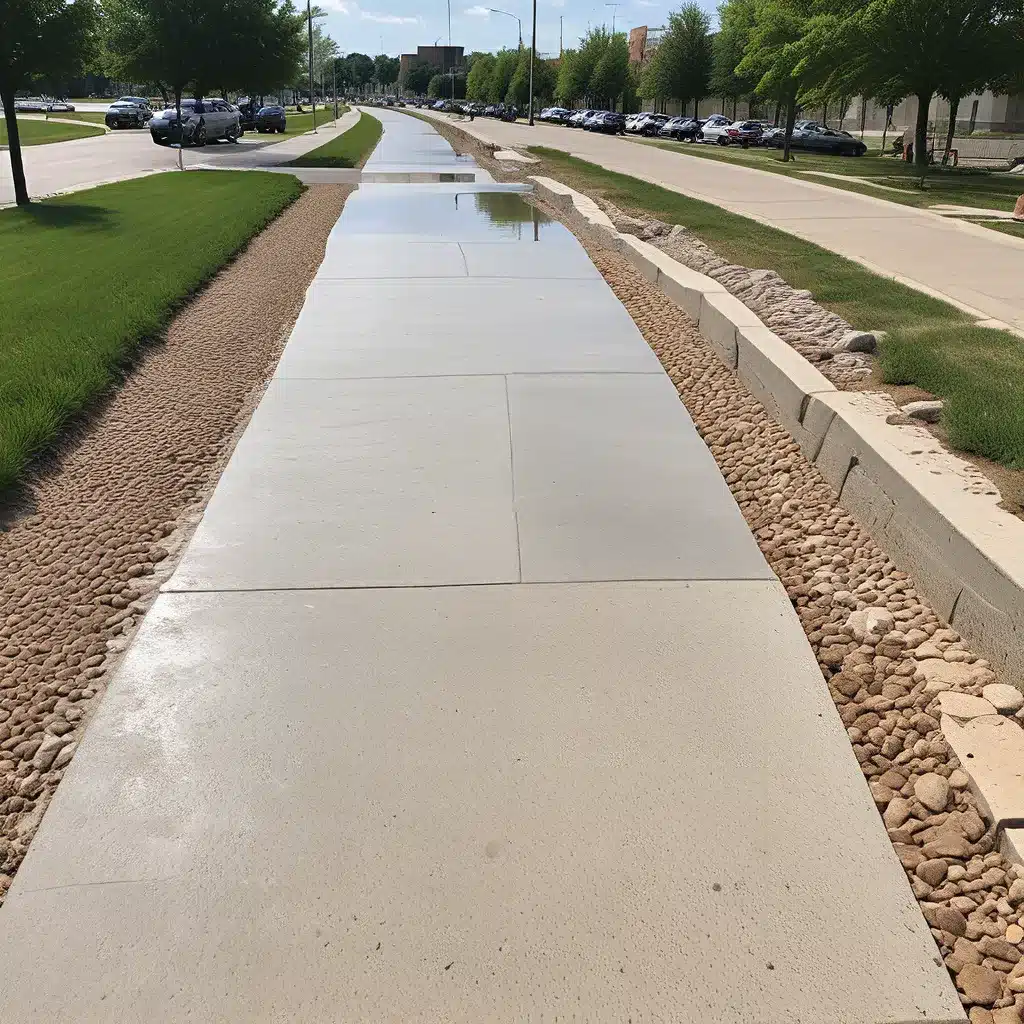
As Kansas City, MO, continues to grapple with the challenges of urban stormwater runoff, one innovative solution is gaining traction: permeable concrete. This porous material offers a unique approach to managing the excess water that can overwhelm traditional drainage systems, all while enhancing the aesthetic appeal and functionality of outdoor spaces.
The Stormwater Challenge in Kansas City
Kansas City’s location at the confluence of the Kansas and Missouri rivers makes it particularly vulnerable to the impacts of heavy rainfall and stormwater runoff. With a significant portion of the city’s landscape covered in impervious surfaces like asphalt and traditional concrete, the ability of the land to naturally absorb and filter water is greatly diminished.
As the city’s Water Services Department has noted, the resulting stormwater can overwhelm the sewer system, leading to potentially harmful overflows and pollution in the local waterways. This not only poses environmental risks but can also have significant financial implications for homeowners and businesses dealing with the consequences of flooding and water damage.
The Rise of Permeable Concrete
To address these challenges, permeable concrete has emerged as a game-changing solution for stormwater management in Kansas City. Unlike traditional concrete, which is impervious to water, permeable concrete is designed with a unique, porous structure that allows rainwater to infiltrate the surface and percolate into the ground below.
As the article on Stormwater.com explains, the idea behind permeable pavement is to decrease the volume of stormwater runoff, thereby increasing the capacity of the sewer system and eliminating the need for costly expansions of sewage treatment plants. This not only benefits the environment but also helps property owners avoid the financial burden of dealing with flooding and water damage.
The Benefits of Permeable Concrete
Permeable concrete offers a range of compelling benefits for property owners and the broader community in Kansas City:
-
Stormwater Management: By allowing water to infiltrate the ground, permeable concrete reduces the burden on the city’s sewer system, helping to mitigate the risk of flooding and combined sewer overflows.
-
Water Quality Improvement: As rainwater filters through the permeable surface and the underlying aggregate, it can help remove pollutants and sediment, improving the quality of the water that eventually reaches local waterways.
-
Aesthetic Appeal: Permeable concrete, especially when used in the form of clay pavers, can add a visually appealing and durable hardscaping element to residential and commercial properties, enhancing the overall design and curb appeal.
-
Durability and Longevity: Properly installed permeable concrete systems can have a lifespan of over a century, making them a wise long-term investment for property owners.
-
Ease of Maintenance: While regular maintenance is recommended to keep the porous surface clear of debris, the upkeep of permeable concrete is generally more straightforward than traditional concrete or asphalt.
Permeable Concrete in Action: The West Bottoms Project
One prominent example of permeable concrete in action in Kansas City is the Central Industrial District (CID) Green Infrastructure Project in the city’s West Bottoms neighborhood. As the Stormwater.com article highlights, this 34-acre development project utilized clay permeable pavers to help minimize urban stormwater runoff from the expansive paved areas.
The project, led by engineering firm HNTB Corporation, demonstrates how permeable concrete can be effectively integrated into large-scale commercial and industrial developments, providing both stormwater management benefits and an attractive, durable hardscaping solution.
Maintenance and Rehabilitation of Permeable Concrete
While permeable concrete offers numerous advantages, it is essential to properly maintain the system to ensure its long-term performance. Over time, the gaps between the pavers can become clogged with soil and debris, reducing the infiltration capacity and causing water to pool on the surface.
To address this challenge, innovative solutions like the Typhoon System, developed by Pave Tech in partnership with Pine Hall Brick Company, have emerged. As the Stormwater.com article explains, the Typhoon System uses a combination of compressed air and vacuum technology to effectively clean the joints between permeable pavers, removing debris and restoring the system’s drainage capabilities.
Cost Considerations and Long-Term Value
While the initial cost of installing permeable concrete systems may be higher than traditional pavement options, a lifecycle analysis can demonstrate the long-term value and potential cost savings.
As the article mentions, a project in New Albany, Ohio, used a lifecycle analysis model to conclude that the use of StormPave permeable clay brick pavers from Pine Hall Brick Company was ultimately less expensive than conventional asphalt and storm drains when factoring in the expected cost of maintenance in future years.
Trends and Adoption of Permeable Concrete in Kansas City
The growing adoption of permeable concrete, particularly in the form of clay pavers, is evident in various markets, including the Northeast and other regions. As the Stormwater.com article notes, “In the Northeast they are putting in more clay than concrete,” and this trend is likely to continue as more municipalities and property owners recognize the benefits of this innovative stormwater management solution.
In the case of Kansas City, the city’s Water Services Department has taken a proactive approach by creating the CID Green Infrastructure Project, demonstrating the potential for permeable concrete to play a significant role in the city’s efforts to manage stormwater and comply with EPA regulations.
Conclusion: Embracing the Future of Concrete in Kansas City
As Kansas City continues to grapple with the challenges of urban stormwater runoff, the adoption of permeable concrete, especially in the form of clay pavers, offers a promising solution that combines practical functionality with aesthetic appeal.
By investing in this innovative technology, property owners and the city as a whole can contribute to a more sustainable and resilient future, while also enjoying the long-term benefits of durable, low-maintenance hardscaping solutions. As the trends and case studies demonstrate, the future of concrete in Kansas City is porous, innovative, and focused on environmental stewardship.
For more information about the benefits of permeable concrete and how it can be integrated into your residential or commercial property, please visit Concrete Contractor Kansas City.

